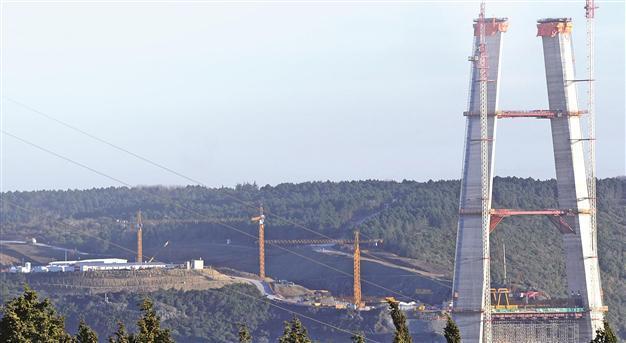Museums not informed of artifacts during Istanbul third bridge construction
Ömer Erbil ISTANBUL / Radikal

The contractors building Istanbul’s third bridge have failed to perform their legal duty and inform museums regarding the myriad archaeological findings unearthed on the roads connecting to the new bridge crossing the Bosphorus, according to two senior archaeologists.
According to the section regarding the cultural patrimony in the environmental impact assessment report (ÇED), which was prepared by the pair, the route of the third bridge’s roads will cross a numbers of sites that should be examined and excavated.
“Considering the archaeological potential of the area, a field examination of the construction sites should be carried out with the cooperation of the Regional Cultural Heritage Protection Boards following deforestation. It is imperative that activities that include physical intervention be carried under the watch of experienced archaeologists,” the report said.
According to the legislation, the contractors have the obligation to halt construction and inform the closest museum regarding archaeological findings unearthed during the works. Regional Cultural Heritage Protection Boards can also rule that construction works be conducted under the supervision of museum officials. But no such steps were undertaken by the firms rushing to finish the bridge before a 2015 deadline.
Zeus Ourios temple on route
Archaeologists were only able to cover a portion of 26.5 kilometers for the ÇED report, but their limited research contains a number of important findings.
According to the report, there are many archaeological traces including ceramic pieces, ancient graves and caves. Archaeologists have said the temple of Zeus Ourios is also said to be located near the bridge’s foundations, on top of a hill on the Asian shores of the Bosphorus. They also cite mythological works which describe a temple dedicated to Cybele in the same portion between the villages of Anadolukavağı and Poyrazköy.
According to a previous Radikal report, the pathway of the third bridge will also cross through eight archaeological sites:
- A first-degree archaeological site including the İnceğiz caves and the ancient Maltepe necropolis in the European-side districts of Çatalca and Silivri.
- The Anastasian Walls, also known as the long walls of Thrace in Silivri.
- The Kırkçeşme water tunnel in the districts of Gaziosmanpaşa and Sultangazi.
- The ancient city of Ispartakule-Spradon, considered a first- and third-degree archaeological site in Avcılar.
- Ancient tombs near the Şamlar village, located in the district of Arnavutköy.
- Kartepe caves in Çatalca, considered a first-degree natural site and second-degree archaeological site.
- The Roman ruins of Philippi near the Sazlıbosna village in Arnavutköy, considered a first-degree archaeological site.
- A first-degree archaeological site neat the Küçükkılıçlı village in Silivri.
Experts said the amount of time necessary for such archaeological works would considerably delay the conclusion of the project, which is set to be completed by the end of next year.
The new road will also connect to a contentious third airport, which will be built on the city’s European side at the expense of a huge forested area.
 The contractors building Istanbul’s third bridge have failed to perform their legal duty and inform museums regarding the myriad archaeological findings unearthed on the roads connecting to the new bridge crossing the Bosphorus, according to two senior archaeologists.
The contractors building Istanbul’s third bridge have failed to perform their legal duty and inform museums regarding the myriad archaeological findings unearthed on the roads connecting to the new bridge crossing the Bosphorus, according to two senior archaeologists.